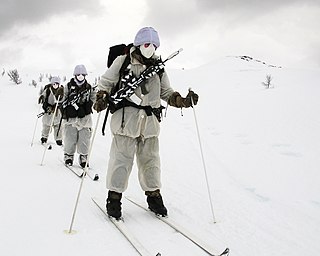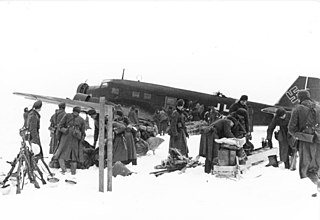Die Frontschau (English:The Front Show) is a series of German World War II era military training films, shown to German soldiers shortly before deployment to the Eastern Front. These films were directed by the veteran propagandist Fritz Hippler, best known for Der Ewige Jude .
The installments in the series are:

The Bernhardt Line was a German defensive line in Italy during the Italian Campaign of World War II. Having reached the Bernhardt Line at the start of December 1943, it took until mid-January 1944 for the U.S. Fifth Army to fight their way to the next line of defences, the Gustav Line. The line was defended by XIV Panzer Corps, part of the German Tenth Army.

Cold-weather warfare, also known as arctic warfare or winter warfare, encompasses military operations affected by snow, ice, thawing conditions or cold, both on land and at sea. Cold-weather conditions occur year-round at high elevation or at high latitudes, and elsewhere materialise seasonally during the winter period. Mountain warfare often takes place in cold weather or on terrain that is affected by ice and snow, such as the Alps and the Himalayas. Historically, most such operations have been during winter in the Northern Hemisphere. Some have occurred above the Arctic Circle where snow, ice and cold may occur throughout the year. At times, cold or its aftermath—thaw—has been a decisive factor in the failure of a campaign, as with the French invasion of Russia in 1812, the Soviet invasion of Finland in 1939, and the German invasion of the Soviet Union during World War II.

The 212th Infantry Division was a German infantry division that fought in World War II. It was destroyed in Lithuania, and reconstituted as the 578th Volksgrenadier Division before being renamed the 212th Volksgrenadier Division.

The 8th Panzer Division was a formation of the WehrmachtHeer. The division was formed by reorganising the 3rd Light Division in October 1939. It was transferred to the west and fought in the Battle of France, in May 1940, and the German invasion of the Balkans in April 1941. Soon after the division advanced towards Leningrad under Army Group North in Operation Barbarossa, and would remain on the eastern front for the remainder of the war. Staying on defensive fronts, it saw action in the relief of Kholm in 1942, Orel and the withdrawals of Army Group Centre in 1943, until transferred to Army group South. The division then fought in a series of retrograde movements, back through Ukraine, into Hungary and finally into Silesia and surrender in May 1945.

The Battle of Velikiye Luki, also named Velikiye Luki offensive operation, started with the attack by the forces of the Red Army's Kalinin Front against the Wehrmacht's 3rd Panzer Army during the Winter Campaign of 1942–1943 with the objective of liberating the Russian city of Velikiye Luki as a previous part of the northern pincer of the Rzhev-Sychevka Strategic Offensive Operation.
The 11th Panzer Division was an armoured division in the German Army during World War II, established in 1940.
The 4th Panzer Army was a German panzer formation during World War II. As a key armoured component of the Wehrmacht, the army took part in the crucial battles of the German-Soviet war of 1941–45, including Operation Barbarossa, the Battle of Moscow, the Battle of Stalingrad, the Battle of Kursk, and the 1943 Battle of Kiev.

The Demyansk Pocket was the name given to the pocket of German troops encircled by the Red Army around Demyansk, south of Leningrad, during World War II's Eastern Front. The pocket existed mainly from 8 February to 21 April 1942.

Operation Iskra, a Soviet military operation in January 1943 during World War II, aimed to break the Wehrmacht's siege of Leningrad. Planning for the operation began shortly after the failure of the Sinyavino Offensive. The German defeat in the Battle of Stalingrad in late 1942 had weakened the German front. By January 1943, Soviet forces were planning or conducting offensive operations across the entire German-Soviet Front, especially in southern Russia; Iskra formed the northern part of the wider Soviet 1942–1943 winter counteroffensive.

The 44th Infantry Division was formed on 1 April 1938 in Vienna, about two weeks after the Anschluss of Austria. It first saw combat at the start of the war in the Invasion of Poland, and also took part in the Battle of France in 1940. After a 9-month period of coastal defence the division was transferred East. On 22 June 1941, the division took part in the invasion of the Soviet Union, attached to Army Group South. It remained in the east after the failure of "Operation Barbarossa", taking part in defensive actions for the winter against the Soviet Army offensives near Izum and Kharkov. Refurbished, the division participated in the German summer offensive, and was subsequently destroyed with the 6th Army at Stalingrad in January 1943.
The 79th Infantry Division(79. Infanterie-Division) was an infantry division of Nazi Germany's Wehrmacht during World War II.

The 216th Infantry Division was a German Army division that was created during the Second World War; it was active from 1939–1943. It served on the Western Front in 1940 and later took part in the Eastern Front campaign, being involved in the disastrous Battle of Kursk.

The 30th Infantry Division of the Wehrmacht was created on 1 October 1936 in Lübeck and mobilized on 26 August 1939 for the upcoming invasion of Poland. At that time, it consisted of the usual German infantry division elements: three infantry regiments of three battalions each, one three-battalion regiment of light artillery, one battalion of heavy artillery, a panzerjager (anti-tank) battalion, an aufklärungs (reconnaissance) battalion, a signals battalion, a pioneer (engineer) battalion, and divisional supply, medical, and administrative units.

The 88th Infantry Division was a major fighting formation of the German Army (Wehrmacht). It was created in December 1939, and first saw combat in the Battle of France, and was then posted to security duties. From December 1941, the division was shifted to the southern sector of the Eastern Front, where it fought until February 1944 when it was encircled near Cherkassy and virtually destroyed.
The 342nd Rifle Division began forming in September 1941, as a standard Red Army rifle division, in the Saratov oblast. It arrived at the front southwest of Moscow in December, in time to take part in the winter counteroffensive. During most of 1942 and into 1943 the division served in primarily defensive roles in 61st Army along the northern face of the German-held salient around Oryol. Following the Soviet victory at Kursk the 342nd took part in the operation that eliminated that salient, and then in the further offensives that liberated Bryansk and pushed on towards Smolensk and the Dniepr River. During these tactical-level actions the division distinguished itself sufficiently to be re-designated as the 121st Guards Rifle Division, one of the last Guards divisions to be formed before the postwar period. In November 1944, a new 342nd was formed in the Far East, and saw action against Japanese forces in northern Manchuria, assaulting across the Sungach river during the Soviet invasion of that region. Well after the war this formation was re-designated and became the 33rd Motor Rifle Division.
The 42nd Rifle Division was a unit of the Red Army during the Great Patriotic War. The division, first formed in 1940, was nearly destroyed in the opening days of the Operation Barbarossa defending the Brest Fortress. Disbanded in late December 1941 and immediately reformed in the Volga Military District. The division then served on the front until disbanded at the end of the war.

The 112th Infantry Division was a German Army infantry division active in World War II.

The 258th Infantry Division was an infantry unit of the German Army in World War II.

The 215th Infantry Division (215.Infanterie-Division) was a major military unit of the German Army that served in World War II.
The 262nd Rifle Division was an infantry division of the Red Army during World War II.